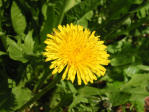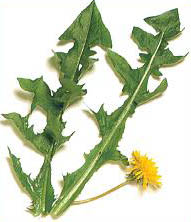Dandelion
Dandelion – Taraxacum officinale / COMPOSITAE Sunflower family
Other Common Names:
Common Dandelion, Blowball, weed
General:
There are a multitude of species of dandelion growing in the temperate regions of Europe, Asia, and North America. Dandelions are a perennial or biennial herb but many consider them an invasive weed. Many consider dandelions to be the worst lawn weed there is, even paying for lawn services and using herbicides to eradicate these lowly plants from the face of the earth. Many of the dandelions you see in your lawn are invasive, brought to North America by Europeans.
Description:
Dandelions have hollow flower stems that ooze a bitter milky liquid if broken. The plants are as short as 2” but can also be as tall as 18”. The leaves are typically thin, deep green and coarsely toothed. The shiny and hairless leaves are clustered, growing from plant base in spreading rosette. The long, thick taproot typically goes straight down. Each stem has a single flower head or seed head. Plants can have multipe flowers on individual stems.
The flower is bright yellow to orange in color. The flower ultimately turns into a white ball of seed heads.
Location:
Abundant throughout North America; open fields, roadsides and lawns. Any place with enough sun and water can hold dandelions – even the sidewalk cracks in my front yard.
Season:
The plant grows and blossoms in early spring through summer and into the fall. The edibles can be picked from spring through fall.
Edible:
Leaves and root.
 Preparation:
Preparation:
Young leaves harvested before flowers appear can be used in salads or cooked like domestic greens. They are nutritious so if in need, do not pass up. Older leaved have a tendency to be bitter. To remove bitterness, cook the leaves in water, change the cooking water and bring to a boil again. That should remove the bitterness.
Roots are best dug in autumn and should be dried uncut until hard. Like chicory root, dried roots are slowly roasted and ground as a coffee substitute. You can also just scrape the roots and boil in a little salt water.
Notes of Interest:
Superior source of vitamins, containing a large amount of vitamin A; also B, C, and E as well as calcium, sodium and potassium. Dandelion greens are rated very high nutritionally.
Traditionally, dandelion has been used a diuretic, to increase the amount of urine in order to get rid of too much fluid. It has been used for many conditions where a diuretic might help, such as liver problems and high blood pressure. However, there is no good research on using dandelion as a diuretic in people.
USDA, NRCS. 2014. The PLANTS Database (http://plants.usda.gov , 9 February 2014). National Plant Data Team, Greensboro, NC 27401-4901 USA